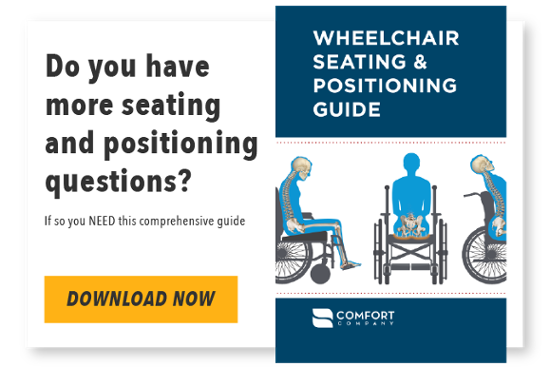Part 4 in our series about Progressive Neurological Disorders. See Part 1, Part 2, and Part 3.
In our last three blogs, I examined progressive neurological disorder and how it should inform our wheelchair seating system choices beginning with the initial therapy evaluation. As I mentioned in the first blog, clients with progressive neurological disorders may have other symptoms that need to be considered during the selection of appropriate seating equipment. In this blog, I will discuss those symptoms more in depth and give some pointers for the selection process.
SENSORY CHANGES
Progressive neurological disorders can be associated with sensory changes. Altered sensation can affect an individual’s tolerance of certain mediums and textures. Understanding this change is critical for equipment selection so the therapist does not unintentionally aggravate the sensory system of an already compromised patient.
For example, Multiple Sclerosis symptoms can include:
- Hypersensitivity
- Numbness
- Tingling
- Pins & Needles
- Crawling Sensations
Pain becomes a huge factor when these sensory changes combine with weakness and discomfort. The patient, as a result, may spend more time in bed than in the chair as the bed provides them with more positional relief from aggravating symptoms. The goal is to provide a wheelchair seating system that can provide support, minimize pain and allow for optimal function during the day, while protecting the skin.
So what do we need to think about in a wheelchair seating system?
Choose a base that allows the user to independently change positions when in need of pain and pressure relief. The following built in functions are critical for independent pain and pressure relief:
- Power Tilt
- Power Recline
- Power Leg Elevation
Choose a variety of wheelchair seat cushions and trial them first. This is always ideal, but with sensory changes it becomes critical.
- With hypersensitivity, the end user needs time with a cushion to see if it can be tolerated.
- With hyposensitivity a pressure map should be used to trial several cushions to ensure optimal skin protection.
- And always consider adjustability. Their condition will change over time and adjustability in a cushion can allow for in field modifications.
Choose a wheelchair back support that can be conformed and adjusted for optimal support and comfort.
- This adjustability is beneficial at initial fitting, but will also allow for adjustments over time as conditions change.
- Consider the ability to add lateral trunk supports and a head support for additional stability.
DECREASED RESPIRATION AND COMMUNICATION
Decreased respiration and communication can be an unexpected challenge that our clients don’t understand when first diagnosed with a progressive neurological disorder. It is not present upon onset of the disease and it is hard for many clients to imagine the progression of the disease and the loss of function that will come.
With the progression of some diseases, the muscles used for breathing are affected resulting in difficulty breathing and producing speech. This difficulty can be made worse by a collapsed posture due to muscle weakness. A typical collapsed posture presents with a posterior pelvic tilt, kyphosis of the thoracic spine, rounded shoulders, and forward head position. This posture restricts the airways and the space the lungs have to take in oxygen. This then results in shallow breathing, difficulty with vocalizations, and decreased oxygenation of the body.
So, what can we do with the Wheelchair seating system? Consider the following equipment suggestions:
Choose a base that allows more open back angle and uses gravity to open the chest cavity and provide rest to the core muscles supporting better respiration and communication.
This can be achieved by ensuring a chair has the following functions:
- Power tilt
- Power recline
- Power leg elevation
Choose a wheelchair seat cushion that provides pelvic stability to minimize posterior pelvic tilt.
- Consider a cushion that has tapered adductors to promote this stability and allow for skin protection.
- Don’t forget adjustability. Because the weakness will progress, an adjustable cushion can be adapted for future strength needs.
Choose a wheelchair back support that will provide thoracic stability, minimizing kyphosis.
- The ability to add laterals is key when thinking ahead, as well as for field adjustability.
- As weakness progresses, you can adjust the back support to stabilize them where they need it, and prevent abnormal postures of the spine.
Consider supporting the upper extremities.
- By adding an upper extremity support you will be able to decrease internal rotation of the shoulders which pull the trunk into forward flexion.
- Proper upper extremity positioning can also decrease the risk of shoulder subluxation that can occur with progressive weakness
Consider the future need for a ventilator.
- The power wheelchair base chosen needs to be able to accommodate the extra weight and space required for a ventilator.
Once again, the theme is: KNOW YOUR DIAGNOSIS AND THINK AHEAD!
Whether we are talking about progressive weakness, impaired sensation, decreased respiration or communication, the key is to choose adjustable components. If you can adjust a wheelchair seat support or a wheelchair back support to increase comfort and stability, you won’t have to figure out a way to justify a new piece of equipment when their condition changes!
By factoring in adjustability when using a power base, you have made it possible to choose other manufacturers' seating components if needed. Don’t be afraid to consult with your ATP to find out all the options to best serve your client in the long run.

Stacey Mullis, OTR/ATP
Director of Clinical Marketing
Stacey is Director of Clinical Marketing. She graduated from Western University in London, Ontario, Canada with a BA Linguistics and BSc Occupational Therapy and has practiced as an OTR for over 20 years. With experience in pediatrics, inpatient/outpatient rehabilitation, long term care, and home health, Stacey has faced the challenges first hand of providing appropriate seating in various clinical settings. This led her to pursue an apprenticeship at Care Partners Seating Clinic in Asheville, NC to advance her skills, and she obtained her ATP certification in 2012. Mullis is a member of the NCOTA, CTF, NRRTs, RESNA, and AOTA.

